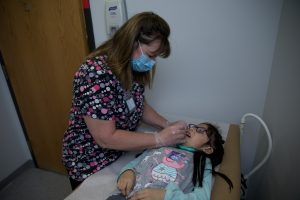Patti DeQuardo has one piece of advice for any clinic thinking about participating in the Wisconsin Medical Dental Integration Project (MDI): just do it.
Participating in MDI is crucial because the project aims to create a statewide system change in health care organizations by integrating a dental hygienist into medical clinics. By doing this, access to preventive dental care will increase and the dental disease burden for young children and pregnant women will decrease.

Patti DeQuardo, RDH, providing care as part of the WI MDI project.
DeQuardo, a Registered Dental Hygienist (RDH) with Sixteenth Street Community Clinic, has been able to see the value that MDI brings to both patients and providers. As an RDH that practices in a public health setting, DeQuardo knows that the convenience for both patients and providers is something that is hard to replicate.
“(MDI) is a convenience for patients because they are receiving twice the knowledge from a dental and medical perspective in one appointment. Where else can you see a dental practitioner and medical provider working together,” she said.
“From the medical provider perspective, they knew we needed MDI and it has been fabulous and far better than everybody thought it would be. At first you don’t realize the value that working together brings, but it brings a large amount of convenience and optimal care for the patient.”
In DeQuardo’s work environment she most frequently works with children and pregnant women and is able to provide assessments, nutrition counseling, oral hygiene instructions, sealants, fluoride varnish and more.
After a patient sees their medical provider, DeQuardo is able to bring her dental supplies in to the patient room and complete her work. At most, she says, her time with patient rarely exceeds 10 minutes so the organization’s work flow is not slowed or thrown off course.
Along with the ability to stay on a consistent, normal schedule, MDI is not a challenge to incorporate into a medical practice. According to DeQuardo, the investment to start is much less than one would assume and billing in the dental world is easy to learn due to a minimal amount of codes.
But even with the technical aspect of MDI out of the way, the most important piece to look at is the value it brings to patients who likely would not have seen a dental provider if it wasn’t for MDI.
“Some of these kids, even at 12 or 13 years old, haven’t seen a dental provider and don’t know the importance of dental health,” DeQuardo said. “No matter the age, prevention is key. Seeing parents and their children at a young age is important because I can catch any issues early before it creates any large problems while providing education.”
Patti has seen three different 3-year-olds six times for basic care before they say their dentist. One parent shared that her child had no fear of the dentist thanks to the previous care Patti provided. Her ability to provide fluoride and education starting when the child’s tooth pops up has resulted in her seeing a decline of cavities in the kids that she sees.
In the end, the time it takes to integrate MDI into a medical practice is worth it. The patients receive a combination of care that they wouldn’t be able to obtain otherwise and both medical and dental providers benefit from the convenience and value of the program.
“If you’re at a clinic that is considering MDI, just do it,” DeQuardo urges. “Looking back on it, the collaboration has been amazing and most of all the value of a patient being able to see both a medical and dental provider at one appointment is something that can’t be accomplished without MDI.”
About MDI
The Wisconsin MDI project is a program of Children’s Health Alliance of Wisconsin in collaboration with the Medical College of Wisconsin. The Wisconsin MDI program is funded by both Advancing a Healthier Wisconsin and Delta Dental of Wisconsin Foundation.


